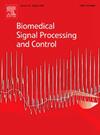FOC-Net: A lightweight network combining full 1 × 1 convolutions with wavelet and attention mechanisms for lung nodule segmentation
IF 4.9
2区 医学
Q1 ENGINEERING, BIOMEDICAL
引用次数: 0
Abstract
Accurate segmentation and analysis of lung nodules are essential for the formulation of effective treatment strategies. However, existing high-performance segmentation algorithms generally depend on substantial computational resources, presenting significant challenges for resource-constrained medical devices, especially edge devices. This study proposes a lightweight and efficient segmentation network called FOC-Net, which replaces large convolutional kernels by using 1 1 convolutions combined with spatial shifting operations. FOC-Net builds a U-shaped encoder–decoder architecture based on the shift convolution residual block (SCR-Block) and three other key modules: the wavelet-based downsampling (WBD) module, which preserves detailed information and suppresses noise, thereby reducing information loss during the downsampling process; the channel-prior spatial attention (CPSA) module, which makes the model focus on lung nodule regions; and the weight-aware feature fusion (WAFF) module, which augments the model’s ability to capture contextual information. Experiments conducted on the LIDC-IDRI dataset demonstrate that the proposed model outperforms other state-of-the-art methods in lung nodule segmentation tasks, achieving a Dice similarity coefficient (DSC) of 92.06% and a Jaccard index (JI) of 85.37%, while maintaining a parameter count of only 0.64 million with GFLOPs of 3.15. Further experiments on the ISIC-2018 skin disease dataset validate the model’s generalization capability, with similar results: a DSC of 89.36% and a JI of 80.77%, still outperforming other state-of-the-art methods.
FOC-Net:将全1 × 1卷积与小波和注意机制相结合的轻量级网络,用于肺结节分割
准确的肺结节分割和分析对于制定有效的治疗策略至关重要。然而,现有的高性能分割算法通常依赖于大量的计算资源,这对资源受限的医疗设备,特别是边缘设备提出了重大挑战。本研究提出了一种轻量级、高效的分割网络,称为FOC-Net,该网络通过使用1 × 1卷积结合空间移位操作来取代大卷积核。FOC-Net构建了一个基于移位卷积残差块(SCR-Block)和其他三个关键模块的u形编码器架构:基于小波的下采样(WBD)模块,它保留了详细信息并抑制了噪声,从而减少了下采样过程中的信息损失;通道优先空间注意(CPSA)模块,使模型专注于肺结节区域;以及权重感知特征融合(WAFF)模块,该模块增强了模型捕获上下文信息的能力。在LIDC-IDRI数据集上进行的实验表明,该模型在肺结节分割任务中的表现优于其他最先进的方法,Dice相似系数(DSC)为92.06%,Jaccard指数(JI)为85.37%,参数计数仅为64万,GFLOPs为3.15。在ISIC-2018皮肤病数据集上的进一步实验验证了该模型的泛化能力,结果相似:DSC为89.36%,JI为80.77%,仍然优于其他最先进的方法。
本文章由计算机程序翻译,如有差异,请以英文原文为准。
求助全文
约1分钟内获得全文
求助全文
来源期刊

Biomedical Signal Processing and Control
工程技术-工程:生物医学
CiteScore
9.80
自引率
13.70%
发文量
822
审稿时长
4 months
期刊介绍:
Biomedical Signal Processing and Control aims to provide a cross-disciplinary international forum for the interchange of information on research in the measurement and analysis of signals and images in clinical medicine and the biological sciences. Emphasis is placed on contributions dealing with the practical, applications-led research on the use of methods and devices in clinical diagnosis, patient monitoring and management.
Biomedical Signal Processing and Control reflects the main areas in which these methods are being used and developed at the interface of both engineering and clinical science. The scope of the journal is defined to include relevant review papers, technical notes, short communications and letters. Tutorial papers and special issues will also be published.
 求助内容:
求助内容: 应助结果提醒方式:
应助结果提醒方式:


